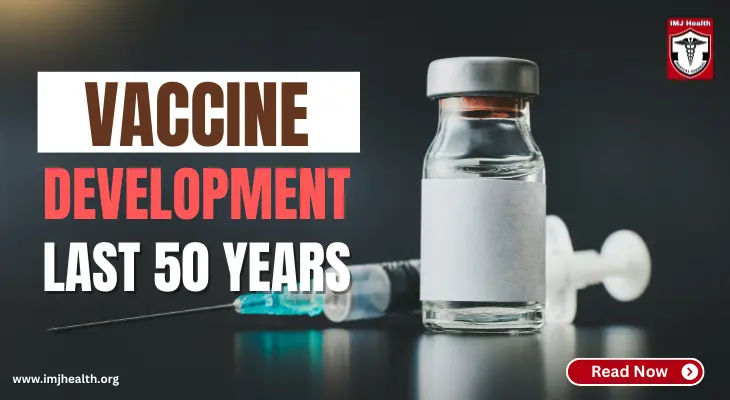How Vaccine Development Has Changed in the Last 50 Years

Vaccine development has dramatically evolved over the past 50 years, shifting from conventional methods to advanced platforms like mRNA, viral vectors, and recombinant proteins. This blog traces the milestones, technologies, and public health impacts that have reshaped immunization strategies worldwide, especially during pandemics and emerging disease threats.
Vaccines are one of the greatest achievements in medicine. Over the past 50 years, the way scientists develop vaccines has improved dramatically. Thanks to new technologies, vaccines are now safer, more effective, and faster to produce.
In this blog, we’ll explore:
- How vaccines were made in the past
- Major breakthroughs in vaccine science
- The role of technology in modern vaccines
- What the future holds
1. Traditional Vaccine Development (Before the 1970s)
Before modern technology, vaccine development relied on observing nature and simple laboratory techniques. Scientists in the early-to-mid 20th century created vaccines by either weakening viruses, killing pathogens, or using bacterial toxins - methods that were groundbreaking for their time but came with limitations. These traditional approaches laid the foundation for immunization but often required years of trial and error, with variable safety and effectiveness.
For most of history, vaccines were made using weakened or killed versions of viruses or bacteria. Some key methods included:
A. Live-Attenuated Vaccines
- Scientists weakened viruses so they couldn’t cause disease but still trained the immune system.
- Examples: Measles, mumps, rubella (MMR), polio (oral vaccine).
B. Inactivated Vaccines
- Viruses or bacteria were killed with heat or chemicals and used in vaccines.
- Examples: Rabies, flu shots (early versions).
C. Toxoid Vaccines
- Some bacteria release harmful toxins (like tetanus or diphtheria). Scientists detoxified these toxins to make vaccines.
Problems with Old Methods:
- ✔ Slow process (took years or decades).
- ✔ Not always safe (some live vaccines could still cause disease).
- ✔ Limited to diseases we could grow in labs.
2. Major Advances in the Last 50 Years:
The last half-century has witnessed a revolution in vaccine science, transforming how we prevent diseases. Starting with genetic engineering breakthroughs in the 1980s to today's mRNA vaccines, researchers have developed smarter, faster ways to trigger immunity. These advancements have not only improved vaccine safety and efficacy but have also allowed us to tackle diseases that were previously considered unconquerable.
A. Genetic Engineering (1980s-1990s)
Scientists started using DNA technology to make vaccines safer and faster.
- Recombinant DNA Vaccines: Instead of growing whole viruses, they used just a piece (like a protein).
- Example: Hepatitis B vaccine (first successful recombinant vaccine).
B. Conjugate Vaccines (1990s)
Some bacteria (like Haemophilus influenzae) tricked the immune system. Scientists combined them with proteins to make them more recognizable.
- Example: Hib vaccine (reduced childhood meningitis).
C. mRNA Vaccines (2020s – COVID-19 Breakthrough)
A revolutionary new method: Instead of using the virus, scientists use messenger RNA (mRNA) to teach cells to make a harmless piece of the virus.
- Faster to develop (COVID-19 vaccines were made in months).
- No live virus needed (safer).
- Example: Pfizer & Moderna COVID-19 vaccines.
3. How Technology Changed Vaccine Development:
Modern vaccine development looks nothing like its early counterparts, thanks to radical technological improvements. Where scientists once relied on growing viruses in chicken eggs, they now use sophisticated genetic sequencing, artificial intelligence, and rapid manufacturing techniques. This technological leap has dramatically accelerated timelines while enhancing precision and scalability in vaccine production.
| Old Methods | New Methods |
|---|---|
| Grew viruses in eggs/lab cells | Use genetic code (mRNA, DNA) |
| Took 10+ years | Can take months (e.g., COVID-19) |
| Limited to certain diseases | Works for cancer, HIV, and more |
| Risk of side effects | More precise & safer |
Key Improvements:
- Computers & AI – Help design vaccines faster.
- Better Safety Testing – Modern clinical trials are stricter.
- Global Collaboration – Scientists worldwide share data (like during COVID-19).
4. The Future of Vaccines:
Vaccine science is advancing faster than ever before, opening doors to revolutionary ways of fighting diseases. Thanks to breakthroughs like mRNA technology, AI-powered research, and needle-free delivery systems, the next generation of vaccines promises to be more effective, accessible, and versatile than we once imagined. From universal shots that protect against multiple virus strains to personalized cancer vaccines that train the immune system to attack tumors, the future of immunization is set to transform global health. In this section, we’ll explore the most exciting developments in vaccine research and how they could change medicine in the coming decade.
Scientists are now working on:
- Universal Vaccines (One flu shot for all strains).
- Cancer Vaccines (Train the body to fight tumors).
- Needle-Free Vaccines (Patches, pills, or nasal sprays).
In 50 years, vaccine science has gone from slow, risky methods to fast, high-tech solutions. With mRNA, AI, and global teamwork, we can now fight diseases better than ever before.
Source of this Blog:
- World Health Organization (WHO) – Vaccine Development
- Centers for Disease Control (CDC) – History of Vaccines
- Nature Journal – mRNA Vaccine Advances
- IMJ Health Research Articles
FAQs on the Evolution of Vaccine Development
1. How were vaccines developed 50 years ago?
In the 1970s, most vaccines were developed using traditional methods like live-attenuated or inactivated pathogens. These techniques required longer development times and extensive laboratory cultivation of viruses or bacteria.
2. What are the major advancements in vaccine technology today?
Modern vaccines use mRNA, viral vector platforms, recombinant proteins, and nanoparticle delivery systems. These technologies offer faster development, higher precision, and reduced side effects compared to older methods.
3. How did the COVID-19 pandemic influence vaccine development?
COVID-19 accelerated the adoption of mRNA vaccines, emergency authorizations, and global collaboration. It also improved cold-chain logistics, digital monitoring systems, and public awareness around vaccine science.
4. Are modern vaccines safer than older ones?
Yes. With advancements in biotechnology, safety profiles have improved through targeted antigen delivery, reduced use of live agents, and rigorous testing protocols during clinical trials.
5. What is the role of AI and bioinformatics in vaccine development?
AI helps predict antigen targets, simulate immune responses, and shorten preclinical research. Bioinformatics plays a role in pathogen sequencing and vaccine design—especially in combating rapidly mutating viruses.
6. How long does it take to develop a vaccine today vs. 50 years ago?
Historically, vaccine development could take 10–15 years. With current platforms (like mRNA), some vaccines can reach the market in 1–3 years, depending on regulatory processes and urgency.
7. What are the future trends in vaccine research?
Upcoming trends include universal vaccines (e.g., pan-influenza), personalized cancer vaccines, thermostable formulations, needle-free delivery, and multi-pathogen vaccines using novel delivery systems.
Contact Medical Journal: IMJ Health
- Website: www.imjhealth.org
- Editor-in-Chief: Dr. Kusum Lata Gaur | MBBS, MD(PSM), CIC (IGNOU), PGCHFWM
(NIHFW) (WHO Fellow IEC)
Professor, PSM & Member of Research Review Board | SMS Medical College, Jaipur (Rajasthan) India - Editor-in-Chief Email ID: info@imjhealth.org
- General Support Email: info.imjh@gmail.com
- Contact us on WhatsApp: Chat Now : +91-7665235235

 October 2025 Articles
October 2025 Articles Submit Article
Publication Fee
Research Areas
Guidelines for Authors
Process of
Publication
Journal Importance
Journal Indexing
Journal Polices
Digital
Identification Number
FAQs
Submit Article
Publication Fee
Research Areas
Guidelines for Authors
Process of
Publication
Journal Importance
Journal Indexing
Journal Polices
Digital
Identification Number
FAQs
| Citation Indices | All | Since 2019 |
| Citation | 280 | 209 |
| h-index | 7 | 7 |
| i10-index | 3 | 1 |
| Acceptance Rate (By Year) | |
| Year | Percentage |
| 2024 | 8.17% |
| 2023 | 10.84% |
| 2022 | 9.14% |
| 2021 | 11.26% |
| 2020 | 11.8% |
| 2019 | 10.3% |
| 2018 | 8.65% |
| 2017 | 12.9% |
| 2016 | 10.9% |
| 2015 | 12.5% |
